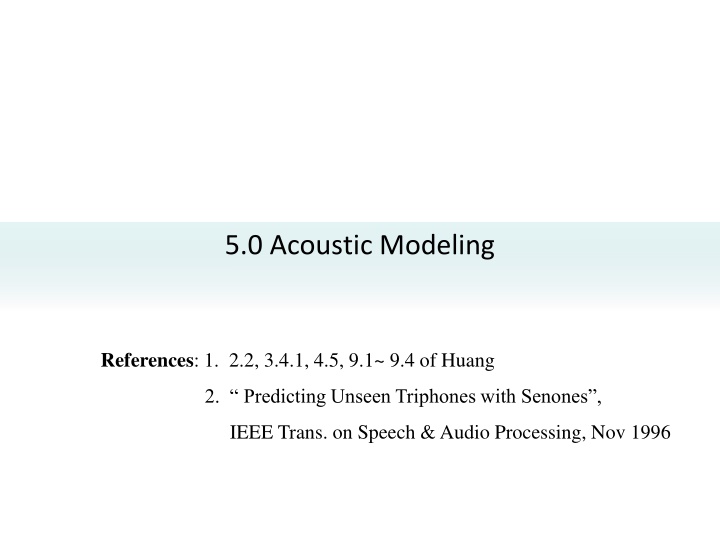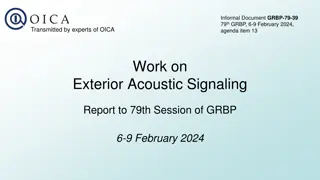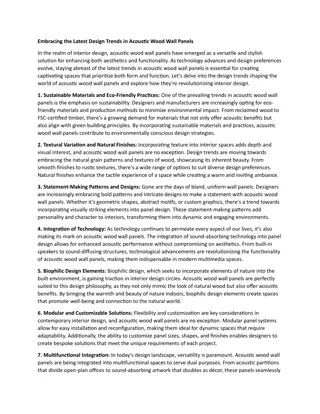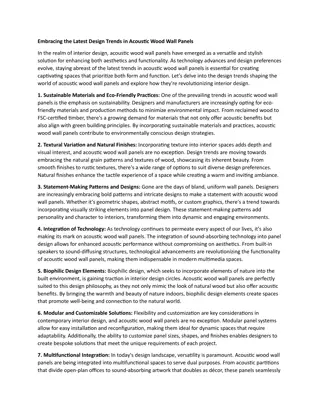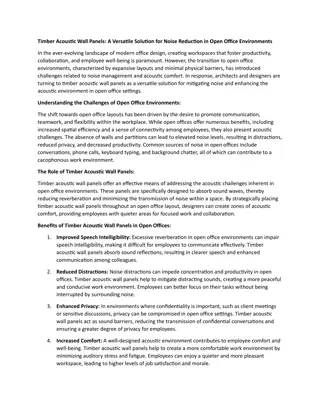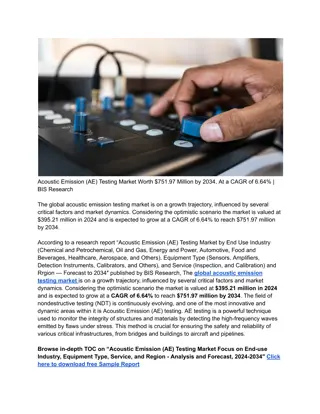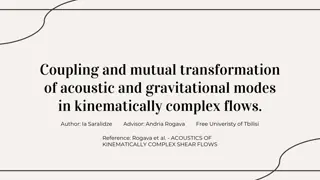5.0 Acoustic Modeling
This content covers topics on acoustic modeling in speech recognition, including unit selection for HMMs, triphones prediction, context dependency, and sharing of parameters. It delves into principles of unit selection, information theory fundamentals, and the generalization of models for accurate speech representation. The references and examples provided offer insights into the complexities of modeling acoustic realizations in speech processing.
Download Presentation

Please find below an Image/Link to download the presentation.
The content on the website is provided AS IS for your information and personal use only. It may not be sold, licensed, or shared on other websites without obtaining consent from the author.If you encounter any issues during the download, it is possible that the publisher has removed the file from their server.
You are allowed to download the files provided on this website for personal or commercial use, subject to the condition that they are used lawfully. All files are the property of their respective owners.
The content on the website is provided AS IS for your information and personal use only. It may not be sold, licensed, or shared on other websites without obtaining consent from the author.
E N D
Presentation Transcript
5.0 Acoustic Modeling References: 1. 2.2, 3.4.1, 4.5, 9.1~ 9.4 of Huang 2. Predicting Unseen Triphones with Senones , IEEE Trans. on Speech & Audio Processing, Nov 1996
Unit Selection for HMMs Possible Candidates phrases, words, syllables, phonemes..... Phoneme the minimum units of speech sound in a language which can serve to distinguish one word from the other e.g. bat / pat , bad / bed phone : a phoneme s acoustic realization the same phoneme may have many different realizations e.g. sat / meter Coarticulation and Context Dependency context: right/left neighboring units coarticulation: sound production changed because of the neighboring units right-context-dependent (RCD)/left-context-dependent (LCD)/ both intraword/interword context dependency For Mandarin Chinese character/syllable mapping relation syllable: Initial ( ) / Final ( ) / tone ( ) tea it two at target
Unit Selection Principles Primary Considerations accuracy: accurately representing the acoustic realizations trainability: feasible to obtain enough data to estimate the model parameters generalizability: any new word can be derived from a predefined unit inventory Examples words: accurate if enough data available, trainable for small vocabulary, NOT generalizable phoneme : trainable, generalizable difficult to be accurate due to context dependency syllable: 50 in Japanese, 1300 in Mandarin Chinese, over 30000 in English Triphone a phoneme model taking into consideration both left and right neighboring phonemes (60)3 216,000 very good generalizability, balance between accuracy/ trainability by parameter-sharing techniques
Sharing of Parameters and Training Data for Triphones Sharing at Model Level Sharing at State Level Shared Distribution Model (SDM) Generalized Triphone clustering similar triphones and merging them together those states with quite different distributions do not have to be merged
Some Fundamentals in Information Theory Quantity of Information Carried by an Event (or a Random Variable) Assume an information source: output a random variable mjat time j U = m1m2m3m4.....,mj: the j-thevent, a random variable S mj x1,x2,...xM , M different possible kinds of outcomes M = i = P(xi)= Prob [mj=xi] , , P(xi) 0, i= 1,2,.....M ( ) 1 P ix 1 Define I(xi)= quantity of information carried by the event mj= xi Desired properties: 1. I(xi) 0 2. I(xi) = 0 3. I(xi) > I(xj) , if P(xi) < P(xj) 4.Information quantities are additive lim ( P I(xi) ) 1 ix P(xi) 1 ) i 0 1.0 = = I(xi) = bits (of information) log log x ( P ) log x ( P i 2 x ( p ) i H(S) = entropy of the source = average quantity of information out of the source each time = = the average quantity of information carried by each random variable M = M ) i x = = ( ) ( ) ( ) log ( ) ( P x I x P x P x E I i i i i = 1 1 i i
Fundamentals in Information Theory M=2, {x1, x2} = {0, 1} U = 1 1 0 1 0 0 1 0 1 0 1 1 0 0 1 S P ( 0 ) = P ( 1 ) = U = 1 1 1 1 1 1 1 1 1 P ( 1 ) = 1 , P ( 0 ) = 0 U = 1 0 1 1 1 1 1 1 1 1 1 0 1 1 1 1 1 1 1 1 P ( 1 ) 1 , P ( 0 ) 0 M=4, {x1, x2,x3, x4} = {00, 01, 10, 11} U = 0 1 S 0 0 1 0 1 1 0 1
Some Fundamentals in Information Theory Examples M = 2, {x1, x2}= {0,1}, P(0)= P(1)= I(0) = I(1) = 1 bit (of information), H(S)= 1 bit (of information) U = 0 1 1 0 1 1 0 1 0 0 1 0 1 0 1 1 0 This binary digit carries exactly 1 bit of information 1 2 1 M =4, {x1, x2, x3, x4}={00, 01, 10, 11}, P(x1)= P(x2)= P(x3)= P(x4)= I(x1)= I(x2)= I(x3)= I(x4)= 2 bits (of information), H(S)= 2 bits (of information) U = 0 1 0 0 0 1 1 1 1 0 This symbol (represented by two binary digits) carries exactly 2 bits of information 1 4 1 0 1 1 3 M = 2, {x1, x2}= {0,1}, P(0)= , P(1)= I(0)= 2 bits (of information), I(1)= 0.42 bits (of information) H(S)= 0.81 bits (of information) U = 1 1 1 0 1 1 1 1 1 0 0 1 1 1 1 1 0 This binary digit carries This binary digit carries 0.42 bit of information 4 4 2 bits of information
Fundamentals in Information Theory M=2, { x1, x2 } = { 0, 1 }, P ( 1 ) = p , P ( 0 ) = 1 - p H ( S ) = - [ p log p + (1-p) log (1-p) ] ? = 101100101001010011 1.0 ? = 111011110111 0.81 H ( S ) ( b i t s ) ? = 1111111 0 p 0 0.25 0.5 0.75 1.0 ? = 0000000 Binary Entropy Function
Fundamentals in Information Theory M=3, {x1, x2,x3} = {0, 1, 2} P(0) = p, P(1) = q, P(2) = 1-p-q [p, q, 1-p-q] H ( S ) = - [ p log p + (1-p-q) log (1-p-q) + q log q ] [1 3,1 3,1 3] [1 6,2 3,1 6] [ 0,2 3,1 [?,1 ? 2,1 ? 3] 2] [1 3,0,2 3] p f i x e d H ( S ) ( b i t s ) [1 3,2 3,0 ] 1.0 0 ? [?,1 ?,0] [?,0,1 ?] [ 0.8,0,0.2 ] q 1.0 0 1 ? 2 1 ? ?
Fundamentals in Information Theory ?(?) ?(??) Information ?1 ?? random ?(?) It can be shown ?(?) 0 ( ) log H S M , M: number of different symbols equality when P(xj)= 1, some j P(xk)=0, k j equality when 1 ?(?) P(xi)= , all i M distribution ?(?) H(S) Entropy random
Some Fundamentals in Information Theory Jensen s Inequality M = M ( p ( q ) i ( p 1 x ) log x ) ( p 1 = x ) log x i i i M = i i i = q(xi): another probability distribution, q(xi) 0, equality when p(xi)= q(xi), all i proof: log x x-1, equality when x=1 ) ( log ) ( i x p x ( q ) 1 i 1 ? 1 ? = ? ( ) q x q x log? i i = ( ) 1 0 i i p x p x i i ( ) ( ) p x i replacing p(xi) by q(xi), the entropy is increased using an incorrectly estimated distribution giving higher degree of uncertainty Kullback-Leibler(KL) Distance (KL Divergence) ) ( i i x q ( ) p x = ( ) ( ) ( ) log 0 i D p x q x p x i difference in quantity of information (or extra degree of uncertainty) when p(x) replaced by q(x), a measure of distance between two probability distributions, asymmetric Cross-Entropy (Relative Entropy) Continuous Distribution Versions
Classification and Regression Trees (CART) An Efficient Approach of Representing/Predicting the Structure of A Set of Data trained by a set of training data A Simple Example dividing a group of people into 5 height classes without knowing the heights: Tall(T), Medium-tall(t), Medium(M), Medium-short(s),Short(S) several observable data available for each person: age, gender, occupation....(but not the height) based on a set of questions about the available data 1 Y N 2 S Y N 1.Age > 12 ? 2.Occupation= professional basketball player ? T 3 N Y 3.Milk Consumption > 5 quarts per week ? 4 t 4.gender = male ? N Y M s question: how to design the tree to make it most efficient?
Node Splitting Goal Goal S s M t T (1 ?) ?(?)(1 ?) ?(?) ?
Splitting Criteria for the Decision Tree Assume a Node n is to be split into nodes a and b weighted entropy H ( ) ( ) ( n c p log n c p i i ) n p(c i )p(n) = n i : percentage of data samples for class i at node n p(n): prior probability of n, percentage of samples at node n out of total number of samples entropy reduction for the split for a question q H H H ) q ( H + = n n a b choosing the best question for the split at each node arg max q H n ) q ( q* = It can be shown = = + ) a ( p ) x ( n H n H ) x ( a D ( H H ) b n a ) x ( b D + ) b ( p ) x ( n a(x): distribution in node a, b(x) distribution in node b n(x): distribution in node n , : KL divergence D weighting by number of samples also taking into considerations the reliability of the statistics Entropy of the Tree T = H ) T ( H terminal n n the tree-growing (splitting) process repeatedly reduces H ( T )
Training Triphone Models with Decision Trees Construct a tree for each state of each base phoneme (including all possible context dependency) e.g. 50 phonemes, 5 states each HMM 5*50=250 trees Develop a set of questions from phonetic knowledge Grow the tree starting from the root node with all available training data Some stop criteria determine the final structure of the trees e.g. minimum entropy reduction, minimum number of samples in each leaf node For any unseen triphone, traversal across the tree by answering the questions leading to the most appropriate state distribution The Gaussian mixture distribution for each state of a phoneme model for contexts with similar linguistic properties are tied together, sharing the same training data and parameters The classification is both data-driven and linguistic-knowledge- driven Further approaches such as tree pruning and composite questions (e.g. ) k j i q q q +
Training Tri-phone Models with Decision Trees An Example: ( _ ) b ( +_ ) 12 yes no sil-b+u 30 a-b+u o-b+u y-b+u Y-b+u 32 46 42 Example Questions: 12: Is left context a vowel? 24: Is left context a back-vowel? 30: Is left context a low-vowel? 32: Is left context a rounded-vowel? i-b+u 24 U-b+u u-b+u e-b+u r-b+u 50 N-b+u M-b+u E-b+u
Phonetic Structure of Mandarin Syllables Syllables (1,345) Base-syllables (408) FINAL s (37) INITIAL s (21) Medials (3) Nucleus (9) Ending (2) Tones (4+1) Consonants (21) Vowels plus Nasals (12) Phonemes (31)
Phonetic Structure of Mandarin Syllables 5 syllables, 1 base-syllable Same RCD INITIAL S ( , , , ) -n -ng (INITIAL s) (FINAL s) Medials ( , , , , , , ) Tone 4 Lexical tones 1 Neutral tone Nasal ending
Subsyllabic Units Considering Mandarin Syllable Structures Considering Phonetic Structure of Mandarin Syllables INITIAL / FINAL s Phone(me)-like-units / phonemes Different Degrees of Context Dependency intra-syllable only intra-syllable plus inter-syllable right context dependent only both right and left context dependent Examples : 113 right-context-dependent (RCD) INITIAL s extended from 22 INITIAL s plus 37 context independent FINAL s: 150 intrasyllable RCD INITIAL/FINAL s 33 phone(me)-like-units extended to 145 intra-syllable right-context- dependent phone(me)-like-units, or 481 with both intra/inter-syllable context dependency At least 4,600 triphones with intra/inter-syllable context dependency
Comparison of Acoustic Models Based on Different Sets of Units Typical Example Results Accuracy Accuracy 70 60 50 40 Accuracy(%) Accuracy(%) 30 20 10 0 Inter- Inter- Demi- Demi- Phone Phone 57.04 57.04 LCD LCD Phone Phone RCD RCD Phone Phone Demi- Demi- Phone Phone Inter-RCD Inter-RCD Phone Phone Inter-RCD Inter-RCD IF IF Triphone. Triphone. backoff backoff Triphone. Triphone. ml.cb ml.cb Triphone. Triphone. ml.rb ml.rb Triphone. Triphone. sl.cb sl.cb Triphone. Triphone. sl.rb sl.rb Triphone. Triphone. sl.rb.nq sl.rb.nq CI Phone CI Phone CI IF CI IF RCD IF RCD IF Accuracy Accuracy 31.47 31.47 44.56 44.56 43.43 43.43 49.19 49.19 50.74 50.74 50.39 50.39 58.56 58.56 55.46 55.46 56.8 56.8 56.1 56.1 56.21 56.21 59.34 59.34 60.77 60.77 61.22 61.22 INITIAL/FIANL (IF) better than phone for small training set Context Dependent (CD) better than Context Independent (CI) Right CD (RCD) better than Left CD (LCD) Inter-syllable Modeling is Better Triphone is better Approaches in Training Triphone Models are Important Quinphone (2 context units on both sides considered) are even better
